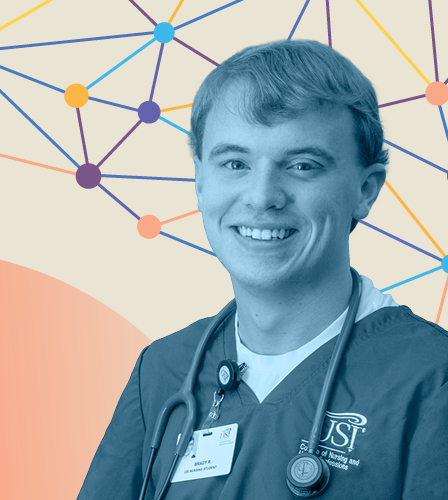
by John Farless
When Ellie Conley showed up for rugby practice on a sunny fall afternoon, she had little idea what was in store for her and the rest of the team.
Just after 4 p.m. on a Wednesday afternoon, a vehicle careened off the eastbound exit ramp of the University Parkway coming to rest precariously on its side across the fence from the USI rugby field.
Conley, a senior nursing major, and her teammates ran toward the accident, scaling the fence to get to the scene. She says it wasn’t what she saw at first as much as what she heard: the sound of a child crying inside the vehicle. Conley, her teammates and several others who had stopped were able to help the child out of the car to safety. Fellow players sat with the child and comforted her. The mother, however, was still trapped inside and experiencing a medical emergency.
In that moment of chaos, through the sound of crying, Conley realized the seriousness of the situation. The Indianapolis native has always wanted to help others and the science of caring for the human body, mixed with the ability to form connections and be compassionate, led to her keen interest in nursing.
She realized the car was balanced on its side at the top of a steep embankment and in danger of rolling back down. By now, several others who'd stopped had positioned themselves to brace the vehicle and prevent it from moving. Conley says she knew what she had to do; she had to get to the woman in the vehicle to render aid. Climbing through the rear hatch, she made her way to the front and began to evaluate the patient, drawing from her nursing training and a recent eight-week rotation in emergency room and acute critical care training. “Each [nursing] student is prepared to face whatever we find when we join the workforce,” she says. “They provide more clinical hours to students than most other nursing schools in the state of Indiana, which allows us to understand our roles.”
Conley's intense training in the program yielded quick action in an emergency. “In that moment, first aid came naturally to me,” she says. “We do a lot of real-life scenarios, and it helped to revert to what was ingrained in me. I’m just grateful to the professors who did that, so I didn’t have to think about it in the moment. There wasn’t a lot on my mind except my first aid training and a big rush of adrenaline. Our personal safety is always top priority, but we often feel drawn to care for our patients.”
The future nurse in Conley did an evaluation of the patient and ensured she was in a stable position and her airways were clear. That’s when she heard a familiar voice. One of those who had stopped to help was Dr. Greg Mendel, USI Instructor in Biology and a chiropractor, who coached Conley in making sure the woman’s neck and spine were supported. Conley, who’d had Mendel as an instructor years earlier, says it was comforting to hear that voice.
Mendel, whose own stepson, Aidan Mercer, was in a serious car accident earlier that summer, ran into the scene, knowing it was those first few moments of care that saved his son’s life after his accident. “After seeing what my son went through and knowing that sometimes the first one there can save a life, I knew I needed to throw myself in there and help in any way I could,” he says. He wanted to get into the car to help but since Conley was already inside, he knew the best thing he could do was help the others stabilize the vehicle. “I was very proud of her,” he says. “She was obviously very well trained. It was great to see the USI community come together and help like this.”
Being inside the car, Conley wasn't aware of how precarious the situation was until she looked up. The passenger window hovered above her and she felt the car rocking. “It scared me, but I knew that little girl was scared too [for her mom].
USI Public Safety Officers Nathan Devillez and Matthew Gabrielli were the first emergency personnel on the scene. They braced the vehicle and got the bystanders out of the way, in case the car fell. When Devillez learned Conley was inside rendering aid, he asked if she was comfortable being in that situation. She was and advised him the patient was unconscious but breathing and that she was “holding C-spine,” a cervical spine stabilization technique used in the field to prevent further injury.
“The vehicle was very unstable, so I stayed just inside the rear and communicated with the student inside,” says Devillez, who has been a Public Safety Officer for four years and a firefighter and EMT with Perry Township for 19 years. “She took a big risk going in there.”
In high school, Conley’s summer job was lifeguarding at the local YMCA. “I’ve never been quick to taking unnecessary risks, but I’ve been trained since age 15 to be protective over those I am responsible for, and to jump in to help whenever I can,” she says.
Suddenly, the woman woke up and started moving around, destabilizing the car even more. Perry Township Fire Department arrived and used stabilizing jacks to secure the vehicle. “Once the patient was conscious, the nursing student did an amazing job of keeping her calm until we were able to get her out. She stayed with her the whole time, and I was just a liaison,” says Devillez, who helped pass medical instruments to Conley, including a neck stabilizing pillow and a pair of sheers she used to cut the seatbelt off the woman to help free her airway. Conley was also able to help get the seats folded down inside to aid with extrication.
“We do this kind of work because we’re trained to do it and we’ve been in situations like this before. Ellie’s never been in a situation like this and that was impressive,” says Devillez. “She went above and beyond anything she needed to do, and she stayed calm the entire time. She went into a car on its side that was not stable and did it knowing she was putting herself in danger. That’s a true testament to who she is as a person.”
With the patient and vehicle secured, members of the Perry Township Fire Department took over and Conley was able to crawl safely out of the vehicle. The woman was successfully removed and transported to the hospital for evaluation and treatment.
Conley could have ended her involvement there but instead moved to the daughter who was still with her teammates nearby. “I braced her a little bit for what was happening, comforted her and steered her away from watching as her mother was being removed,” she says.
Sometimes when people find themselves in challenging situations, they question their life's choices. Not Conley, who was awarded Most Valuable Person by the Perry Township Fire Department for her actions. “I liked the feeling of having the right knowledge and being able to do something productive with those skills,” says Conley, who graduates in May and plans to pursue a hospital career in medical surgery. "I enjoyed working in a medical scenario with other medical professionals. It was a good experience to see first-hand what it takes to work with a team in a situation like this. It reinforced that I’ve chosen the right field.”
Responding to off-campus emergencies is nothing new for USI’s Public Safety. Director Steve Bequette says his officers have responded to multiple injury accidents on the highway adjacent to the University. “We had one instance where an ambulance stopped on the highway by the University with a patient who had just coded,” says Bequette. “They knew our EMTs were close and asked for help with CPR. We’ve also responded to a residence just off campus for a teen who had overdosed. One of our officers administered NARCAN and saved his life.”
Several of USI’s Public Safety officers also work for Perry Township Fire Department which adds to their experience responding to emergencies. Perry Township serves as the first responder for the USI area. “Our officers have a vested interest in both USI and the Perry Township community and it shows,” says Bequette.
Public Safety is also no stranger to the faculty, staff and students in USI’s Health Professions. They have worked with the Health Professions Programs, and specifically the Nursing Program on emergency plans for the Health Professions Center. Recently Public Safety worked with Julie St. Clair, Clinical Assistant Professor of Nursing, on a couple tabletop training exercises that centered around a response to a tornado ripping through the Stone Center in downtown Evansville. Those types of trainings are very well received and add a unique level of preparedness for the campus community.
Long before nursing student Ellie Conley climbed the fence to aid a woman and child in a single-car crash near USI's campus, she'd spent hours learning and practicing what it takes to be a successful first-on-the-scene medical emergency responder. Intense hours mandated by USI’s Nursing Program's 1,200 hours of clinical experience, making it more than twice the required hours of many other programs.
Courses like Care of the Adult III focus on human responses to complex, multi-dimension health problems in adult patients, but also build on the program as a whole, including other medical surgical courses that teach students to be excellent at assessment skills and how to provide interventions. “We give them life threatening scenarios, but we also give them less critically ill scenarios, so they are prepared to function in all areas where they’ll practice," says Dr. Marilyn Ostendorf, Clinical Assistant Professor of Nursing.
It’s not just the number of hours, but the variety of those hours offered. “We offer a huge variety of clinical opportunities, and our students rotate through those experiences,” says Pam Thomas, Clinical Assistant Professor of Nursing. Experiences range from on-campus to local and regional hospitals and other healthcare facilities, but also branch out into the local community. For example, in 2019, the College of Nursing and Health Professions received a four-year grant in excess of $2 million through the U.S. Department of Health and Human Services to increase the number of registered nurses trained in primary care to positively impact health in rural communities.

Born a triplet with a serious medical condition, Brady Robinson '25 became a nurse so he could help other kids one day.

When Jacob Mills '25 experienced difficulty using a traditional mouse in 3D engineering software, he came up with his own solution.

USI's Biometrix Discover Lab reveals how friendly faces improve health outcomes.

Biology majors are not the only USI graduates who go on to work at a zoo. Learn about the behind-the-scenes workings of Evansville's Zoo from alumni who majored in art, geology, public relations, sociology and more.
